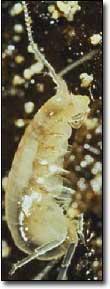Keeping humans away and making habitats moist with plants are among the two best ways to protect and to possibly perpetuate the federally-protected Kaua‘i cave wolf spider and the Kaua‘i cave amphipoid, the U.S. Fish and Wildlife Service says. More
Keeping humans away and making habitats moist with plants are among the two best ways to protect and to possibly perpetuate the federally-protected Kaua‘i cave wolf spider and the Kaua‘i cave amphipoid, the U.S. Fish and Wildlife Service says.
More research and more public education also can contribute to the well-being of the cave dwellers, agency officials said in announcing a draft plan to assist with the recovery of the invertebrates.
Koloa is the only place in the world where the two rare species are found. The invertebrates make their homes in lava tubes and in rocks in caves.
The Kaua‘i cave spider is on the verge of extinction.
The known population of that species number perhaps fewer than 30, and all of the spiders live in a single cave, federal agency officials said.
The federal draft recovery plan is anticipated to help bring together all the entities that would have a stake in saving the cave dwellers, according to Dave Allen, the Pacific regional director for the Fish and Wild-life Service.
Those stockholders include the U.S. Fish and Wildlife Service, agencies with the state of Hawai‘i and interested organizations and citizens, Allen noted in a news release.
Allen said protecting the caves where the two species still exist was among the top priorities of the plan.
The cave amphipod has been regularly found in three caves, including one in which its partner, the cave spider, also calls home, Allen noted.
To protect the cave systems in Koloa, the drafters of the plan recommended:
- Controlling the entry of the caves by humans;
- Preventing the destruction of native plants above the caves; The amphipod lives on the decaying roots of plants.
- Employing a fire control plan;
- Preventing the introduction of nonnative predators and competitors;
- Preventing the introduction of biocontrol organisms of bio-pesticides;
- Preventing contamination of the caves by pollutants, including insecticides and herbicides.
To support the habitats of the cave dwellers, the draft plan recommended encouraging the growth of appropriate plants to increase the humidity in the caves.
The invertebrates appear to require a lot of humidity, perhaps 100 percent, to help with their survivability, Allen noted.
Among other tasks, researchers also should try to get a better handle on the population of the species, look for new cave habitats and look at the feasibility of moving wolf spiders into empty cave, the recovery plan recommended.
By adjusting to life in lava tubes, the wolf spider lost use of its eyes. Instead of building webs to catch prey, the spider grabs its prey. The cave amphipod looks like a shrimp, and like its close friend, the wolf spider, also lost the use of its eyes. The amphipod feeds on the decaying roots of surface vegetation. Both invertebrate species were listed as endangered species by the federal government in Jan. 14, 2000.
As a result of legal action by environmental groups, a federal court ordered Fish and Wildlife Service officials to establish “critical habitat designations” to protect the cave species.
In April 2003, the federal agency officials announced that they had set aside 272 acres in Koloa for that purpose.
The federal agency had initially proposed 4,193 acres in the Koloa area to protect the species, but whittled down the acreage after more thorough scientific studies and amid concerns by some businesses about the potential economic impact such designations might have on landowners in South Kaua‘i. Some landowners voiced concerns about the additional cost of having to build projects around the homes of the cave dwellers. The designation, however, does not set up a preserve or a refuge, and only applies to situations where federal funding or permits are required.


